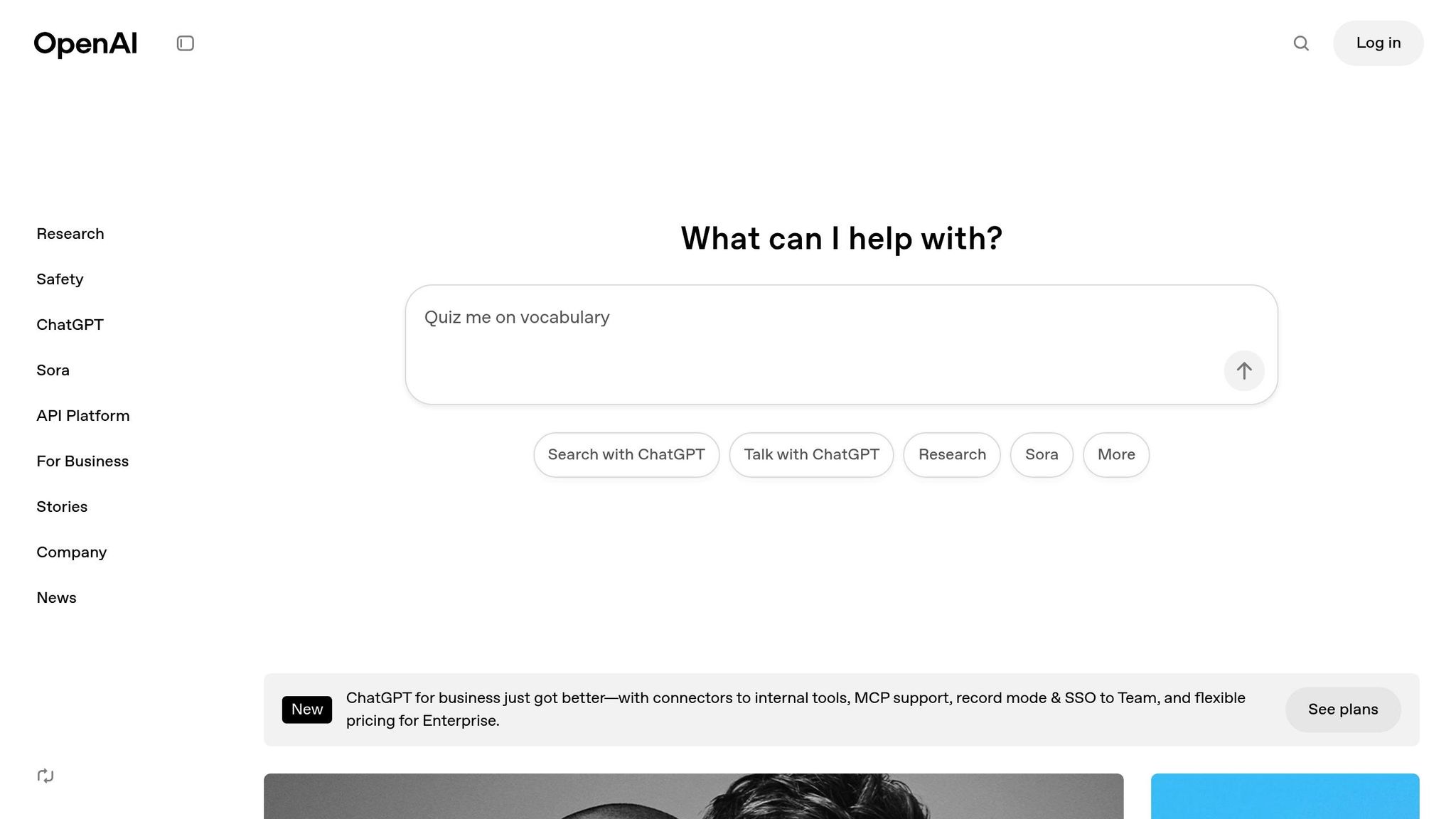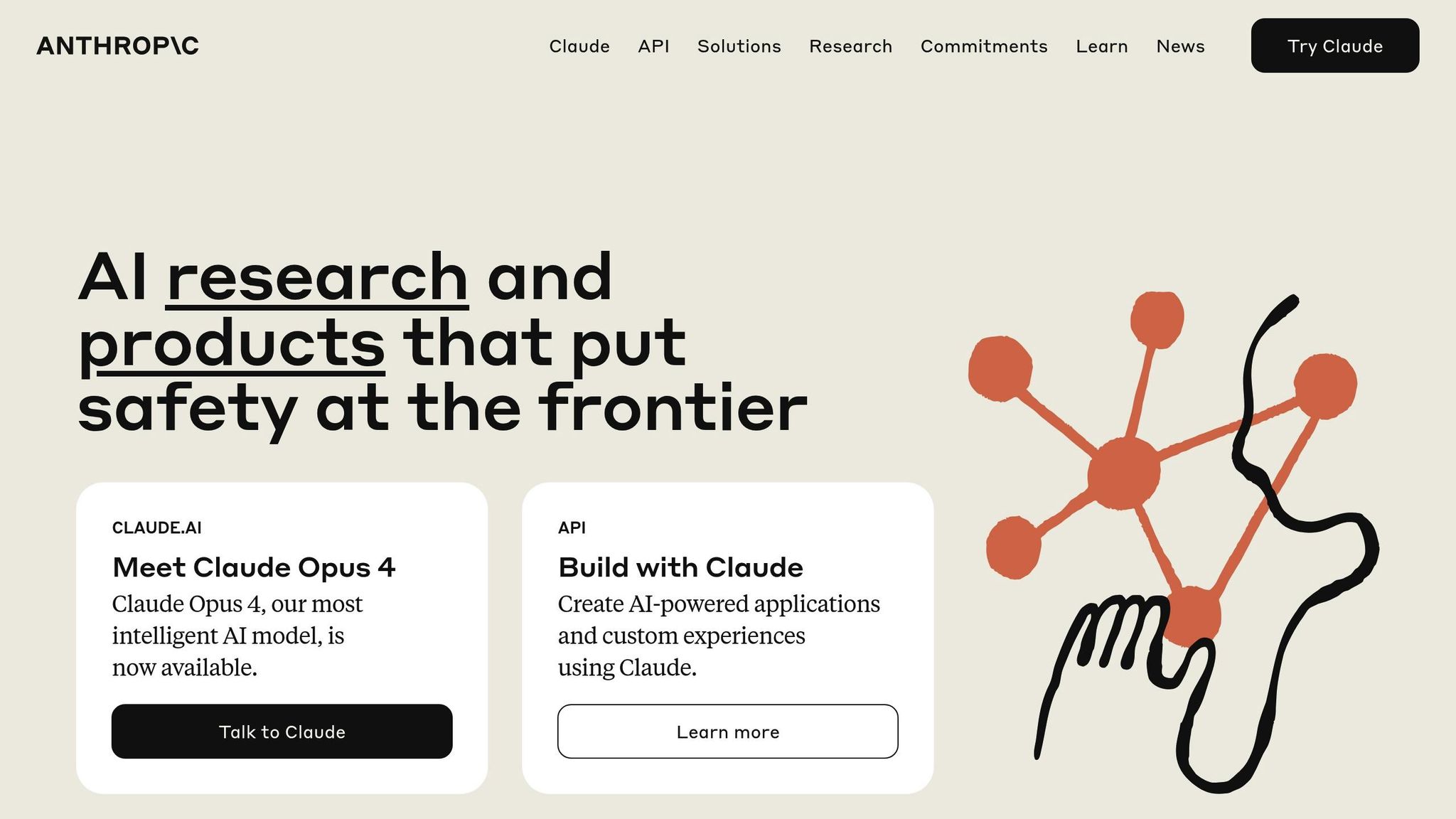Want the top AI language tool in 2025? Here’s an easy guide:
- OpenAI GPT-4/4.5 Turbo: Great for making up stories, coding, and long talks with its 128,000-token mind. Good for many tasks but knows only until Sep 2021. Costs $20 each month for ChatGPT Plus.
- Google Gemini 2.5 Pro: Best for big files (1 million tokens), coding, and works well with Google stuff. Fits big jobs but can talk too much. Costs $20 each month for Gemini Advanced.
- Anthropic Claude 4 (Opus and Sonnet): Puts first safety and right answers, with strong coding and rule-heavy work fit. Deals up to 200,000 tokens. Costs $20 each month for Claude Pro.
Fast Compare Table:
| Model | Good at | Not Good at | Good for | Cost (Month) |
|---|---|---|---|---|
| GPT-4 | New ideas, coding, long texts | Older info (2021), may be biased | Writers, coders, big groups | $20 |
| Gemini 2.5 | Big tasks, coding, Google stuff | Talks too much, gives extra info | Big companies, study folks | $20 |
| Claude 4 | Safe, follows rules, good AI | Sees less at once | Money work, health, private info | $20 |
In Short:
Go for GPT-4 if you need to mix things up, Gemini 2.5 for big tasks, and Claude 4 if you want it safe. Each one is good at different things, so choose what fits your needs best.
The Best LLM Is.... (A breakdown for every category)
1. OpenAI GPT-4 (and GPT-4.5 Turbo)

OpenAI's GPT-4 is a top-notch language tool with better skills and fast work. The new update, GPT-4.1, can deal with up to 25,000 words and it checks facts 40% better. It can also work with images, charts, and graphs well. It runs 40% faster than its past version, GPT-4o, and can hint when more checks or context are needed. Here, let's see how GPT-4 does in some key uses.
Making Content
For those who make content, GPT-4 gives strong and sure text-making. By January 2025, it hit an 88.7% score for correct words on the MMLU test and beat or met human skills in 90.6% of cases. It keeps its sense and flow in long texts, making it great for writers and marketers. Yet, for the best facts, users should ask it clear things and double-check important info.
Coding and Tech Jobs
GPT-4.1 made big steps for coders and tech folks. It got a 54.6% score on the SWE-bench Verified - a 21.4% jump from GPT-4o - and did more than two times better on tests for coding in many languages. Tests inside show 60% better results, use tools 30% more well, and made 50% fewer needless changes in codes. Tests by Qodo show that GPT-4 gave better code tips for 55% of GitHub changes, lowering unneeded edits from 9% to 2%. It knows many coding languages and is good at fixing bugs, but coders should still tweak its outputs for their exact needs.
Helping Customers and Business Uses
GPT-4 has changed customer help for firms in the USA, mainly big ones. Over 80% of Fortune 500 firms now use AI chat tools made with GPT-4. These have cut talks with real people by 25% and deal with 80% of usual questions alone. Also, they have made solving issues take half the time. A big example is Bank of America's AI helper, Erica, which has dealt with 2 billion talks, solving 98% of issues in just 44 seconds. Erica also helps with things like tracking money back and watching subscriptions 56 million times a month.
"ChatGPT Enterprise has cut down research time by an average of an hour per day, increasing productivity for people on our team. It's been a powerful tool that has accelerated testing hypotheses and improving our internal systems."
- Jorge Zuniga, Head of Data Systems and Integrations at Asana
GPT-4 can work well with tools like CRM and HR systems, making it great for many work areas. Firms can shape it with their own words and data to make it work best. But, to use it well, they must keep data safe and train the model all the time.
2. Google Gemini 2.5 (formerly Bard)

Google's Gemini 2.5 has a smart way of solving problems. It tries to give better and more precise answers. You can pick from two kinds: Gemini 2.5 Pro for hard jobs and Gemini 2.5 Flash for fast, cheap work. What stands out is how Gemini 2.5 Pro tops the LMArena list by far. It can handle up to one million tokens, meaning it can work with big blocks of code or long papers without trouble.
"Gemini 2.5 models are thinking models, capable of reasoning through their thoughts before responding, resulting in enhanced performance and improved accuracy."
– Koray Kavukcuoglu, CTO of Google DeepMind
Content Making
Gemini 2.5 grows on its strong points in text and code work, doing well at giving out deep and neat content. The Pro model is great at making tech details, project plans, and meeting words with high true show. Its Deep Research part is top at making full look-ins on many topics. Tests inside show that users like these papers more than others by a big bit. A key thing, Deep Research can also change these into podcast-like forms, making them easy to get.
For things you see, Gemini 2.5 Flash mixes words and pictures well, making look sees with sharp, full words - great for ads and stuff you share. Groups like Kraft Heinz have used this to cut ad make times from eight weeks to just hours fast. Agoda, too, is trying out making fresh trip pictures that turn into videos. These skills to make stuff reach over to tech jobs, where Gemini 2.5 shows great skill.
Code and Tech Jobs
Gemini 2.5 Pro stands out in code work, hitting 63.8% on the SWE-Bench Verified test for hard code stuff and getting a 70.4% pass show on LiveCodeBench v5 for code make. It can build working web apps and games very fast from easy hints. Its big 1 million-token view lets it handle whole code sets, making bug fixes and updates better. It also cuts repeat jobs, helping teams work less.
For one, Google Developer Expert Truong made a GitHub Action with Gemini AI to check pull asks auto, catching wrong bits and bugs soon. The model's good at seeing code rules helps with better code words, and it got 74.0% on the Aider Polyglot test for whole file work. Still, it finds mixed hints hard and shouldn't be seen as all you need instead of people know-how in code. Beyond coding, Gemini 2.5 also makes business work better.
Help for Users and Business Uses
Gemini 2.5 brings its skills to business help, using its text and code strengths. The Flash version works well for big need jobs like chat help, while the Pro version deals with harder jobs that need deep thought. For example, Geotab has Gemini 2.5 Flash in its data person, Ace, to give answers 25% fast while cutting costs by 85% each time.
"With respect to Geotab Ace (our data analytics agent for commercial fleets), Gemini 2.5 Flash on Vertex AI strikes an excellent balance. It maintains good consistency in the agent's ability to provide relevant insight to the customer question, while also delivering 25% faster response times on subjects where it has less familiarity."
– Mike Branch, Vice President Data & Analytics, Geotab
Other firms are also using Gemini 2.5's power. Box uses the Pro kind to run its AI Extract Agents, getting more than 90% right in pulling key points from hard files like scanned PDFs and things written by hand. This beats past kinds in reading parts of text and time thought. In health work, Connective Health brings out main info from health files, while Citizen Health uses it to look at long health record data. This lets people with not common sickness and those who look after them get clear, full of detail answers very fast.
Even small shops gain from Gemini 2.5’s wide use. Newo.ai, for one, mixes the Live API with Gemini 2.5 Flash to make AI helpers that handle both talk and written notes, giving up to 30× ROI. Also, the model can be made to fit special work talk and brand tone. Its Live API helps real-time talk plans too, making it a key tool for many work needs.
sbb-itb-212c9ea
3. Anthropic Claude 4 (Opus and Sonnet)

Anthropic's Claude 4 has two kinds: Opus 4 and Sonnet 4. Opus 4 is made for hard jobs. Sonnet 4 mixes good work, fast speed, and fair cost. Both can deal with tough tasks and follow detailed orders well.
"Claude Opus 4 is our most intelligent model to date, pushing the frontier in coding, agentic search, and creative writing."
One key thing it does well is think before it answers. Claude 4 can use tools like web search while it thinks and is 65% less like to take easy ways out or use tricks than before. This helps it make long and smart content, raising the bar for deep thinking tasks.
Content Creation
Claude 4 is great at making well-built, top-notch content. With better thinking skills and a broad view, Claude Opus 4 can look at many pages at once. This is good for making short overviews or full reports for studies that cover lots of material. Tests show it follows complex steps well, making clean and linked results.
For jobs needing a lot of work and fast results, Claude Sonnet 4 is the best pick. It mixes speed and quality, making it a go-to for crafting blog posts, product info, social media stuff, and more.
Coding and Technical Tasks
Claude 4 sets new rules in coding and solving tech issues. Claude Opus 4 got 72.5% on SWE-bench and 43.2% on Terminal-bench, while Claude Sonnet 4 did a bit better on SWE-bench with 72.7%. In real tests, Rakuten used Claude Opus 4 to change code non-stop for seven hours.
The models also have better ways to link up, letting them run code with new tool APIs. Claude Code does things in the back via GitHub Actions and mixes well with stuff like VS Code and JetBrains. These steps have given real benefits: iGent saw mistakes go from 20% to almost none in app making, while Augment Code had better results with more exact code changes.
Customer Support and Enterprise Applications
Claude 4's skills also help a lot in business use. Its AI Safety Level 3 (ASL-3) rating makes it fit well for areas like finance and health care.
Like, JPMorgan used Claude 4 to handle reports in 2025, saving $30 million a year, lowering wrong flags in fraud checks by 20%, and cutting bias in credit scores by 15%. Also, the Mayo Clinic picked Claude 4 for reading medical files, dropping the time needed by 30% while meeting tough safety needs.
Business folks like how exact it is, too. Kodif uses Claude Sonnet to manage refunds and call-offs, while Varsha Mahadevan, a top engineer at Coinbase, said it could "bring a billion customers to the crypto world".
Like GPT-4 and Gemini 2.5, Claude 4 fits well for specific industry needs, doing great in sensitive areas. Prices show this focus: Claude Opus 4 is $15 per million input tokens and $75 per million output tokens, and Claude Sonnet 4 is cheaper at $3 per million input tokens and $15 per million output tokens.
Good and Bad Parts
After we looked at what each model could do before, let’s go over what makes them great and where they fall short. Every big language model (LLM) has good points and bad points, and knowing these helps a lot when picking the best one.
GPT-4 is great for trustworthy and creative tasks. OpenAI points out this edge:
"The difference comes out when the complexity of the task reaches a sufficient threshold - GPT‑4 is more reliable, creative, and able to handle much more nuanced instructions than GPT‑3.5"
This model works with 26 languages and can handle both words and pictures for many uses. Yet, GPT-4 has its bounds: it knows only up to September 2021, and though it makes fewer slips than past models, it can still sometimes make wrong or biased results.
Gemini 2.5 Pro shines with its think and code skills. Google DeepMind's big tech guy, Koray Kavukcuoglu, talks about it as:
"Gemini 2.5 is a thinking model, designed to tackle increasingly complex problems"
This model tops in code tests, getting a 69.0% pass rate on LiveCodeBench and 88.0% on AIME 2025. It can look at 1 million words (and soon 2 million), letting it work with big data sets. But, Gemini 2.5 Pro talks too much, often adding not needed code notes.
Claude 4 gets good words for being safe and smart, with a 72.5% score on SWE-bench. But, it only takes words as input and has a small view of 200,000 words, which cuts down how well it can work with mixed data.
These good and bad points fit with past reviews, helping you pick the right model for your needs.
| Model | Key Strengths | Main Weaknesses |
|---|---|---|
| GPT-4 | Works in many modes, knows 26 languages, can create, does well on tests | Info stops at Sept 2021, might see things that aren't there, may be biased |
| Gemini 2.5 Pro | Great at thinking, can handle big info blocks (1M tokens), good at coding, works with Google | Uses too many words, sometimes adds unneeded code notes, might guess wrong |
| Claude 4 | Top-notch safety, good at thinking | Only takes text, smaller info block (200K tokens), can't work in many modes |
Test scores show more gaps. For one, GPT-4 hit the 90th spot on the Uniform Bar Exam, way above GPT-3.5's 10th spot. At the same time, Gemini 2.5 Pro showed its skill in coding by scoring 63.8% on SWE-Bench Verified.
Which Big Word Tool to Pick?
Picking the right big word tool (LLM) depends on what you need, how much you can spend, and how it fits into your work steps. Here's a guide to help you pick:
For One Maker or Small Groups
If you're making things alone or with a few others, you might need help with writing or code. OpenAI's GPT-4 is a good choice for making new texts, as it's strong and can do many things. If you need to work on code, though, Anthropic's Claude 4 (Sonnet type) is great for coding in languages like Python, Go, and Java. It's important to weigh cost against how well it works - pick what best meets your project needs.
For Big Teams and Large Firms
For big teams, making sure the LLM fits your big goals is key. Beatriz Sanz Saiz, who leads the AI team at EY, says:
"One of the most common mistakes companies make is failing to align the LLM selection with their specific business objectives. Many organizations get caught up in the hype of the latest technology without considering how it will serve their unique use cases."
If you need fast and big growth, Google's Gemini 2.5 Pro works well. It can handle up to 1 million tokens in one go and can make more than 370 tokens each second. On the other hand, Claude 4 is great for keeping things safe and by the rules, making it top for jobs that need care with data or have hard rules.
Tips for Each Job Area
Each job area has its own needs:
- Healthcare and Finance: Safety and fair play are key, so Claude 4 is the best pick.
- Technology and Software Development: For top coding skills, both GPT-4 and Claude 4 are strong picks.
Start with small tests using real data and grow as you see good results. As Naveen Kumar Ramakrishna, a top software man at Dell Technologies, says:
"It's surprising how often the problem isn't well-defined, or the expected outcomes aren't clear. Without that foundation, it's almost impossible to choose the right model and you end up building for the wrong goals."
FAQs
How do GPT-4, Gemini 2.5, and Claude 4 do when faced with hard coding tasks?
When it gets to tough coding tasks, Claude 4 leads with a top score of 72.5% on SWE-bench. This shows it can handle hard code stuff well. Gemini 2.5 is next, with a score of 63.8%, and gives a good mix of strong work and ease of use. GPT-4, on the other hand, gets 54.6%, making it a solid pick for normal coding work, but less so for very tricky issues.
If you care most about right and fast results in hard coding spots, Claude 4 tops the list. For those who want both good work and a range of uses, Gemini 2.5 is a good fit.



